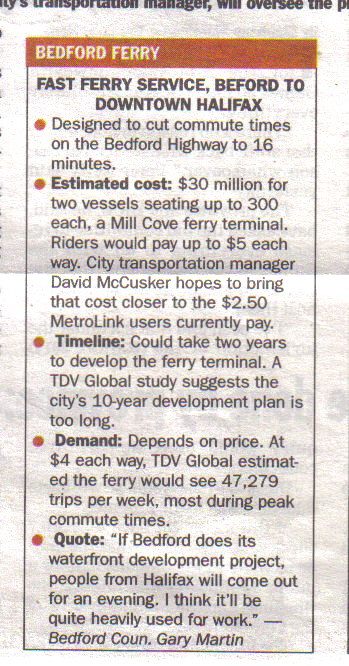 june13/07
june13/07
MEDIA

|
April 12, 2007
|
||||||||||
|
||||||||||
|
|
||||||||||
How bad is it? According to the city's transit advisory committee, the system is struggling, and in some cases, failing. In minutes from a February 2006 meeting, the committee said "existing service deficiencies (overcrowding on buses, commuters being left standing at the bus stop due to overcrowding, the inability to extend services and to promote transit use due to a lack of resources) must be addressed." The defeated tone was clearer at a meeting last October: "It is difficult to promote and encourage Metro Transit use in HRM due to the capacity issues and the inability to handle the current demands on the system." Facing little hope of bringing in new riders, Transit has to squeeze its present riders hard. People who work in public transport talk about the "farebox recovery ratio," which compares a transit system's costs to the money riders pay for their tickets. For example, New York's recovery ratio is around 30 percent, so only 30 percent of costs are paid by riders, leaving 70 percent for government funding—and some advertising revenue—to cover. In other words, for every dollar a rider pays, there is a government subsidy of $2.33. In Halifax, with a ratio around 70 percent, the situation is the opposite: For every dollar a rider pays, government coughs up 43˘. Halifax's transit system is one of the least-subsidized in Canada, and thus one of the least public. City officials often point to the lack of provincial and federal funding to account for Metro Transit's problems. But "we're holding out for handouts" is more excuse than explanation. City council is too unsure of the pent-up Transit demand to make the initial investment in a better system, and today's loads of potential new riders can't start enjoying the bus until the system is better. It's a classic chicken-and-egg situation. Except for the Rolling Stones. For September's big show, the city actively discouraged Stones fans from driving, and promised special, efficient bus service. The four Stones routes were colour-coded—blue, green, orange, red—to help new riders, instead of using the oblique 1 to 185 route system daily riders have to parse. The buses and ferries ran later into the night, so were more available to people on a downtown schedule. And 35,000 of the 50,000 concert goers used Transit, paying almost all the costs with a recovery ratio of 92.9 percent. "As anticipated," says the city's final report on the show, "the lack of any major special-event parking accommodations on the Peninsula was effective in increasing transit ridership and reducing traffic congestion." Halifax is grappling with some big problems related to traffic congestion, from the offensive plan to widen Chebucto Road to that whole global warming planetary catastrophe thing. And there are other costs of supporting Halifax's notoriously bad drivers, including a rash of pedestrian deaths that has council wanting to spend $7 million on crosswalk bling. But there is a veritable army of potential bus riders out there, desperate for a chance to help the city. Councillors, it's time to change your priorities. Leave the cars alone. Put more public money into public transit. Put your two cents into my electronic farebox: editor@thecoast.ca |
||||||||||